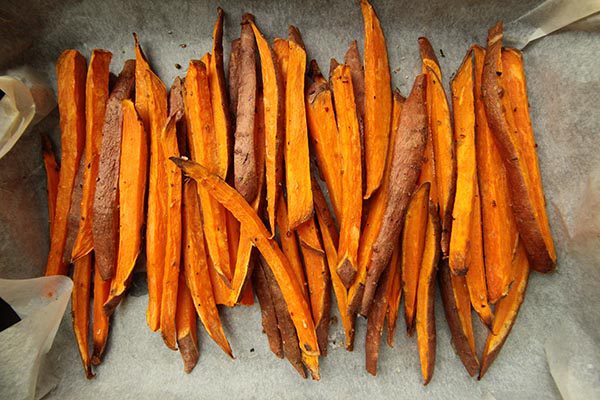
Over the weekend, a friend of mine posted a Facebook photo of a meal he was having in Nashville. One of those huge burgers that are four inches high, and sweet potato fries.
I opined that although I like sweet potato fries myself, many people complain that they just don’t have the crispiness of traditional french fries.
Looking through a Googled list of sweet potato recipes, I can imagine that many cooks would tell me that that isn’t true: you can make them crispy and that they (maybe exclusively) know how. (Air fryers are a popular option.)
I am fond of sweet potatoes (sweetpotatoes, if you’re in North Carolina [editor’s note: or California]), and my family eats them year-round on a more or less weekly basis.
Nonetheless, there is some truth to the complaint. Sweet potato fries are, as a rule, just not very crispy. I have to assume that the countless restaurants that serve them have some idea of cooking them, and that this is the best they can do on any consistent basis.
The global sweet potato business is big.
One statistic:
“The global Sweet Potato Fries market size is estimated to be worth USD 3459.9 million in 2021 and is forecast to a readjusted size of USD 5870.6 million by 2028 with a CAGR of 7.7 Percent during the forecast period 2022-2028.”
The answer I propose: a new sweet potato variety designed specifically for fries. It would have the same characteristically appealing taste and color, but would pass through the inferno of deep frying and come out crispy.
Such a variety would of course appeal more to the frozen side of the industry rather than the fresh, but I think huge numbers of home cooks would be interested in a sweet potato that made its way through their ovens and air fryers in a more satisfying form than they now get.
If you take this idea, run with it, and become the new J.R. Simplot, you owe me a dinner at a nice restaurant—with or without sweet potatoes.
Over the weekend, a friend of mine posted a Facebook photo of a meal he was having in Nashville. One of those huge burgers that are four inches high, and sweet potato fries.
I opined that although I like sweet potato fries myself, many people complain that they just don’t have the crispiness of traditional french fries.
Looking through a Googled list of sweet potato recipes, I can imagine that many cooks would tell me that that isn’t true: you can make them crispy and that they (maybe exclusively) know how. (Air fryers are a popular option.)
I am fond of sweet potatoes (sweetpotatoes, if you’re in North Carolina [editor’s note: or California]), and my family eats them year-round on a more or less weekly basis.
Nonetheless, there is some truth to the complaint. Sweet potato fries are, as a rule, just not very crispy. I have to assume that the countless restaurants that serve them have some idea of cooking them, and that this is the best they can do on any consistent basis.
The global sweet potato business is big.
One statistic:
“The global Sweet Potato Fries market size is estimated to be worth USD 3459.9 million in 2021 and is forecast to a readjusted size of USD 5870.6 million by 2028 with a CAGR of 7.7 Percent during the forecast period 2022-2028.”
The answer I propose: a new sweet potato variety designed specifically for fries. It would have the same characteristically appealing taste and color, but would pass through the inferno of deep frying and come out crispy.
Such a variety would of course appeal more to the frozen side of the industry rather than the fresh, but I think huge numbers of home cooks would be interested in a sweet potato that made its way through their ovens and air fryers in a more satisfying form than they now get.
If you take this idea, run with it, and become the new J.R. Simplot, you owe me a dinner at a nice restaurant—with or without sweet potatoes.
Richard Smoley, contributing editor for Blue Book Services, Inc., has more than 40 years of experience in magazine writing and editing, and is the former managing editor of California Farmer magazine. A graduate of Harvard and Oxford universities, he has published 12 books.



